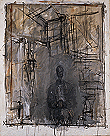
Alberto Giacometti
Diego
1953
Solomon R. Guggenheim Museum

Alberto Giacometti
Portrait of Isaku Yanaihara
(Portrait d'Isaku Yanaihara)
1956
Centre Georges Pompidou,
Musée national d'art moderne
|
The word “Dada,” having different meanings in various languages, refers to an art movement that emerged during World War I in Zurich, Barcelona, and New York and later in Berlin, Cologne, and Paris. Dada artists such as Jean Arp, Marcel Duchamp, Max Ernst, George Grosz, Raoul Hausmann, Francis Picabia, and Sophie Taueber-Arp produced some of the most antirational, anarchic, and humorous work of the twentieth century, mocking the bourgeois values thought to be responsible for the horrors of war. Traveling between Europe and New York, Picabia established a trans-Atlantic dialogue between the Paris and New York Dadaists, informing each of the other's practices, until the groups finally disbanded in the early 1920s. In 1924, the writer André Breton, who had earlier been part of the Dada movement, wrote the first manifesto of Surrealism, a literary and artistic movement that advocated an art of pure imagination, drawing upon Sigmund Freud's ideas of dream analysis and the unconscious. Like the Dadaists who preceded them, the Surrealists promoted a spirit of social revolt, using practices of free association, chance, and accident to create disturbing images and juxtapositions that disrupt conventional notions of stable form and conscious thought. Known as “the Pope of Surrealism,” Breton claimed several artists for the movement, including Arp, Giorgio de Chirico, Duchamp, and Picabia, but excommunicated others at will, such as Giacometti, because the artist had begun to work directly from the model rather than his imagination. Giacometti's portraits, often of members of his family, show his concern with rendering figures in space, their images appearing isolated in the network of lines. These works speak to the condition in postwar Europe, evoking a sense of alienation and the need to rebuild that which had been lost. Although both the Musée national d'art moderne and the Solomon R. Guggenheim Museum have substantial collections of Surrealism today, neither seriously acquired this kind of art until late in its development. Not until 1974, when the MNAM became part of the Centre Georges Pompidou and was subsequently given its own independent budget to purchase art, did the museum begin to acquire Surrealist work in depth. In the 1950s, under the direction of James Johnson Sweeney, the Guggenheim expanded the scope of its collection and began to collect Surrealist work. In 1976, the Surrealist holdings of the Guggenheim Foundation were dramatically increased with the bequest of the Peggy Guggenheim Collection in Venice. Peggy Guggenheim, the niece of Solomon R. Guggenheim, was an intimate part of the Surrealist circle, as well as a promoter of the work of its members through her Guggenheim Jeune gallery (1938-39) in London and Art of This Century gallery/museum (1942-47) in New York. She developed a renowned collection of Cubist, Surrealist, and abstract works with the help of several art historians and artists, including Duchamp and Ernst, to whom she was married from 1941 to 1943. |
 Alberto Giacometti Diego 1953 Solomon R. Guggenheim Museum |
 Alberto Giacometti Portrait of Isaku Yanaihara (Portrait d'Isaku Yanaihara) 1956 Centre Georges Pompidou, Musée national d'art moderne |